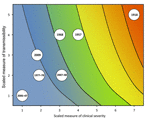Novel framework for assessing epidemiologic effects of influenza epidemics and pandemics - PubMed (original) (raw)
Novel framework for assessing epidemiologic effects of influenza epidemics and pandemics
Carrie Reed et al. Emerg Infect Dis. 2013 Jan.
Abstract
The effects of influenza on a population are attributable to the clinical severity of illness and the number of persons infected, which can vary greatly between seasons or pandemics. To create a systematic framework for assessing the public health effects of an emerging pandemic, we reviewed data from past influenza seasons and pandemics to characterize severity and transmissibility (based on ranges of these measures in the United States) and outlined a formal assessment of the potential effects of a novel virus. The assessment was divided into 2 periods. Because early in a pandemic, measurement of severity and transmissibility is uncertain, we used a broad dichotomous scale in the initial assessment to divide the range of historic values. In the refined assessment, as more data became available, we categorized those values more precisely. By organizing and prioritizing data collection, this approach may inform an evidence-based assessment of pandemic effects and guide decision making.
Figures
Figure 1
Estimates of influenza deaths in the 2010 United States population (308,745,538 persons) across varying values of case-fatality ratio and the cumulative incidence of infection in the population. Selected estimated numbers of deaths are indicated with a black line, across each relevant combination of case-fatality ratio and cumulative incidence. In addition, the background color transitions from blue to yellow to red as the estimated absolute number of deaths increases.
Figure 2
Framework for the initial assessment of the effects of an influenza pandemic.
Figure 3
Framework for the refined assessment of the effects of an influenza pandemic, with scaled examples of past pandemics and past influenza seasons. Color scheme included to represent corresponding estimates of influenza deaths in the 2010 US population as shown in Figure 1.
Figure 4
Framework for the refined assessment of the effects of an influenza pandemic, stratified by age group with scaled examples from the 2009 pandemic. Color scheme included to represent corresponding estimates of influenza deaths in the 2010 US population as shown in Figure 1.
Similar articles
- Comparison of pandemic (H1N1) 2009 and seasonal influenza viral loads, Singapore.
Lee CK, Lee HK, Loh TP, Lai FY, Tambyah PA, Chiu L, Koay ES, Tang JW. Lee CK, et al. Emerg Infect Dis. 2011 Feb;17(2):287-91. doi: 10.3201/eid1702.100282. Emerg Infect Dis. 2011. PMID: 21291608 Free PMC article. - [Transmissibility and severity of the pandemic influenza A (H1N1) 2009 virus in Spain].
Simón Méndez L, de Mateo Ontañón S, Larrauri Cámara A, Jiménez-Jorge S, Vaqué Rafart J, Pérez Hoyos S; en representación del Sistema de Vigilancia de Gripe en España (SVGE). Simón Méndez L, et al. Gac Sanit. 2011 Jul-Aug;25(4):296-302. doi: 10.1016/j.gaceta.2011.02.008. Epub 2011 May 2. Gac Sanit. 2011. PMID: 21543138 Spanish. - Surveillance for influenza during the 2009 influenza A (H1N1) pandemic-United States, April 2009-March 2010.
Brammer L, Blanton L, Epperson S, Mustaquim D, Bishop A, Kniss K, Dhara R, Nowell M, Kamimoto L, Finelli L. Brammer L, et al. Clin Infect Dis. 2011 Jan 1;52 Suppl 1:S27-35. doi: 10.1093/cid/ciq009. Clin Infect Dis. 2011. PMID: 21342896 - Influenza pandemic epidemiologic and virologic diversity: reminding ourselves of the possibilities.
Kasowski EJ, Garten RJ, Bridges CB. Kasowski EJ, et al. Clin Infect Dis. 2011 Jan 1;52 Suppl 1:S44-9. doi: 10.1093/cid/ciq010. Clin Infect Dis. 2011. PMID: 21342899 Review. - Transmission parameters of the A/H1N1 (2009) influenza virus pandemic: a review.
Boëlle PY, Ansart S, Cori A, Valleron AJ. Boëlle PY, et al. Influenza Other Respir Viruses. 2011 Sep;5(5):306-16. doi: 10.1111/j.1750-2659.2011.00234.x. Epub 2011 Mar 31. Influenza Other Respir Viruses. 2011. PMID: 21668690 Free PMC article. Review.
Cited by
- Data-driven modeling for different stages of pandemic response.
Adiga A, Chen J, Marathe M, Mortveit H, Venkatramanan S, Vullikanti A. Adiga A, et al. ArXiv [Preprint]. 2020 Sep 21:arXiv:2009.10018v1. ArXiv. 2020. PMID: 32995364 Free PMC article. Updated. Preprint. - [SARS-CoV-2/COVID-19-epidemiology and prevention].
Salzberger B, Buder F, Lampl B, Ehrenstein B, Hitzenbichler F, Holzmann T, Schmidt B, Hanses F. Salzberger B, et al. Nephrologe. 2021;16(1):3-9. doi: 10.1007/s11560-020-00472-0. Epub 2020 Dec 15. Nephrologe. 2021. PMID: 33343742 Free PMC article. Review. German. - [Epidemiology of SARS-CoV-2/COVID-19].
Salzberger B, Buder F, Lampl BT, Ehrenstein B, Hitzenbichler F, Holzmann T, Schmidt B, Hanses F. Salzberger B, et al. Gastroenterologe. 2020;15(6):443-451. doi: 10.1007/s11377-020-00479-y. Epub 2020 Oct 29. Gastroenterologe. 2020. PMID: 33144889 Free PMC article. Review. German. - Development of Framework for Assessing Influenza Virus Pandemic Risk.
Trock SC, Burke SA, Cox NJ. Trock SC, et al. Emerg Infect Dis. 2015 Aug;21(8):1372-8. doi: 10.3201/eid2108.141086. Emerg Infect Dis. 2015. PMID: 26196098 Free PMC article. - Pandemic Risk Assessment Model (PRAM): a mathematical modeling approach to pandemic influenza planning.
Dover DC, Kirwin EM, Hernandez-Ceron N, Nelson KA. Dover DC, et al. Epidemiol Infect. 2016 Dec;144(16):3400-3411. doi: 10.1017/S0950268816001850. Epub 2016 Aug 22. Epidemiol Infect. 2016. PMID: 27545901 Free PMC article.
References
- Fiore AE, Uyeki TM, Broder K, Finelli L, Euler GL, Singleton JA, et al. Prevention and control of influenza with vaccines: recommendations of the Advisory Committee on Immunization Practices (ACIP), 2010. MMWR Recomm Rep. 2010;59(RR-8):1–62 . - PubMed
- Centers for Disease Control and Prevention. Interim pre-pandemic planning guidance: community strategy for pandemic influenza mitigation in the United States, February 2007. [cited 2012 Nov 19]. http://www.flu.gov/planning-preparedness/community/community_mitigation.pdf
MeSH terms
LinkOut - more resources
Full Text Sources
Other Literature Sources
Medical
Miscellaneous



